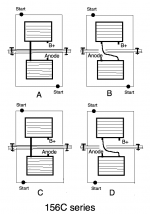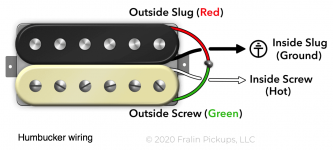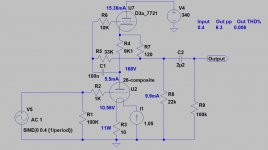Let's assume a tube with up to 10K Rp such as DHTs or indirectly heated like 12AT7, 6N1P.
For a line stage or input to a 2 stage SE amp, and assume a current of up to 15mA.
The plate choke will need over 100H, and could be plain steel, amorphous, nickel, nano-crystalline.....
Assume you listen to a lot of classical music and opera and instrumental tone is very important to you.
What's your choice here? And what have been your personal experiences with either or both?
For a line stage or input to a 2 stage SE amp, and assume a current of up to 15mA.
The plate choke will need over 100H, and could be plain steel, amorphous, nickel, nano-crystalline.....
Assume you listen to a lot of classical music and opera and instrumental tone is very important to you.
What's your choice here? And what have been your personal experiences with either or both?
The "problem" of the inductive load of large (for example 5-10k) Rp tubes is the inductance .. and the quality.
100H choke is only 12 566 Ohm at 20Hz, so it's good for 3-4k Rp tubes.
The most of large (up to 100H) inductance chokes not primarily designed as anode load with -enough- DC current, not properly interleaved and constructed for low interwinding capacitance, tend to humming/interference.
There are very few manufacturer make -good- anode chokes, and the -very good- chokes are pricy toys.
Using active load is another compromise: SS or tube, larger B+, dissipation, etc.
100H choke is only 12 566 Ohm at 20Hz, so it's good for 3-4k Rp tubes.
The most of large (up to 100H) inductance chokes not primarily designed as anode load with -enough- DC current, not properly interleaved and constructed for low interwinding capacitance, tend to humming/interference.
There are very few manufacturer make -good- anode chokes, and the -very good- chokes are pricy toys.
Using active load is another compromise: SS or tube, larger B+, dissipation, etc.
The "problem" of the inductive load of large (for example 5-10k) Rp tubes is the inductance .. and the quality. 100H choke is only 12 566 Ohm at 20Hz, so it's good for 3-4k Rp tubes.
The most of large (up to 100H) inductance chokes not primarily designed as anode load with -enough- DC current, not properly interleaved and constructed for low interwinding capacitance, tend to humming/interference.
There are very few manufacturer make -good- anode chokes, and the -very good- chokes are pricy toys.
Indeed, all true. Pricy toys. The thing is that in my case I've never managed to get the same instrumental tone out of an active load as out of a good plate choke, and I know and read of others who have said the same. We're talking here of strings with a nice sheen on them, realistic woodwinds with their own particular woody or reedy sounds, voices, pianos and so forth.
I'd like to hear from those with active loads that have achieved this, and from those who have had success with good chokes and can recommend good examples.
Highlighting one part in the whole electronic/acoustic line is very circumstantial thing, if you concentrate to only the "hearing" (and not "measuring").
Even if the "active load" and "plate load" versions working (well) at same operating point and FR also the same (usually not, the choke theoretically "more rounded", than active), the nuances may matters a lot.
If the elements of signal line "forces more" one of the part of audible range (for example the loudspeaker pulls a little to high), but the other part of line offset this the ordinary tonal balance may overtone if you use wider spectrum component.
Even if the "active load" and "plate load" versions working (well) at same operating point and FR also the same (usually not, the choke theoretically "more rounded", than active), the nuances may matters a lot.
If the elements of signal line "forces more" one of the part of audible range (for example the loudspeaker pulls a little to high), but the other part of line offset this the ordinary tonal balance may overtone if you use wider spectrum component.
The active load may well have a brighter high treble when used with higher Rp tubes, but the tone and timbre of woodwinds, voices and other acoustic instruments is more a characteristic of the mid range of frequencies, which should be flat in both cases. So I suspect it has more to do with the harmonic spectrum.If the elements of signal line "forces more" one of the part of audible range (for example the loudspeaker pulls a little to high), but the other part of line offset this the ordinary tonal balance may overtone if you use wider spectrum component.
I only tried with these tubes. If you have high gm triode, try it.
The output impedance about 250-350R (1kHz).
The output impedance about 250-350R (1kHz).
Could be good, but I need more volts! For my 2a3 amp the B+ is around 310v.Andy, try high gm tube (for example trioded D3a/E280F/E180F etc.) as active load.
I would be curious to see if it's also on brighter side or not.
Another thing you can do is put 2 plate chokes in series, which has been done with the 156C from Hammond. This works quite well - you get 300H. I'm using this right now at 9.5mA though it's rated 8mA and while not as good as my amorphous NP Acoustics chokes it's still OK and the treble response is fine.
Think outside the box . . .
The Third alternative:
Very High Voltage B+, a plate load resistor, RL, of high resistance.
The highest voltage example I can remember: A single triode of a 6SN7, a very high resistance RL, and 1200V at the top of RL.
That drove a very high voltage capacitor, and the RG and grid of a Western Electric 212E.
It sounded great!
(no choke load; no active current source).
The Third alternative:
Very High Voltage B+, a plate load resistor, RL, of high resistance.
The highest voltage example I can remember: A single triode of a 6SN7, a very high resistance RL, and 1200V at the top of RL.
That drove a very high voltage capacitor, and the RG and grid of a Western Electric 212E.
It sounded great!
(no choke load; no active current source).
The highest voltage example I can remember: A single triode of a 6SN7, a very high resistance RL, and 1200V at the top of RL.
That drove a very high voltage capacitor, and the RG and grid of a Western Electric 212E.
It sounded great!
(no choke load; no active current source).
Very hard to make sensible comparisons here. The 1200v means using very different parts. Cannot think of any PS/coupling caps i like that will work at such voltages. Unless rated at 630v and used in series, which obviously quadruples cost. And it's not just the caps. Any good sounding high voltage resistors? It's a brand new investigation into component selection.
Fwiw, based on sound alone, i would only use inductive loads. Semiconductor CCS works just fine in the tails of differential amps but imposes too strong a signature as a plate load. An entirely subjective preference of course.
Worth mentioning i just don't use 10k tubes anywhere. The inductive requirements are impossible to meet while retaining quality.
My phono stage uses a CCS loaded ECC81 as the second gain stage (single 10M45, 4mA, 170Vish at the anode from 240V supply feeding into a cathode follower output) and it can portray a good range of accurate, to my ears, tonal colours of instruments.
Yes - that's a Tango originally so should be good. Not cheap, but plate chokes do cost a bit. They are distributed from the Netherlands as well.ISO RC-160-15 plate choke is -1dB at 25Hz and 40kHz with 10k Rp and 15mA.
In response to 6a3, yes I do like a resistor and they do sound pure and natural, but I don't want to drop the gain if I can avoid it. And I don't want to go above the 310v or so B+ or use a negative supply. I often feel there's a conspiracy against a really good and easy to implement 2 stage SE amp. Yes, an active load solves the problem but at what cost for the tonality and naturalness of acoustic instruments?
I agree with analog-sa, from my own listening, that I would use a choke in place of an active load. And I agree that the lower the Rp the better. But apart from the 6922 which I don't like very much, or the 6SN7 which doesn't have enough gain for a 2 stage SE amp, the triodes that I like most are around 10K Rp. Otherwise it's a lot of pentodes in triode, like C3g, D3a etc. I'd prefer a true triode where possible. It's all a conspiracy to outwit the DIY amp builder.
I am a firm believer, in this case, of Resistentialism. Worth looking up in Wiki for a laugh. It believes that inanimate objects have spiteful intentions towards humans, and it's battle cry is "les choses sont contre nous".
https://en.wikipedia.org/wiki/Resistentialism
Last edited:
What about an active load and a plate choke in series?Could be good, but I need more volts! For my 2a3 amp the B+ is around 310v.
Another thing you can do is put 2 plate chokes in series, which has been done with the 156C from Hammond. This works quite well - you get 300H. I'm using this right now at 9.5mA though it's rated 8mA and while not as good as my amorphous NP Acoustics chokes it's still OK and the treble response is fine.
When the choke runs out of induction at low frequencies, the active load continues.
Jantzen Audio makes some very nice 1200V coupling caps. Could be worth a try!Think outside the box . . .
The Third alternative:
Very High Voltage B+, a plate load resistor, RL, of high resistance.
The highest voltage example I can remember: A single triode of a 6SN7, a very high resistance RL, and 1200V at the top of RL.
That drove a very high voltage capacitor, and the RG and grid of a Western Electric 212E.
It sounded great!
(no choke load; no active current source).
Smart thinking maybe? Choke on top of active load or visa versa? Or a resistor in series with a plate choke?What about an active load and a plate choke in series?
When the choke runs out of induction at low frequencies, the active load continues.
When talking about loads in series, can anyone solve the question of how to wire up 2 Hammond 156C chokes in "humbucking" mode, back to back? Gary Pimm posted
".. you can mount the chokes on standoffs, bottom to bottom and wire the chokes with one winding backwards. This makes the pair of chokes hum buckers. In my test setup the pair of chokes picked up 20dB less hum than a single choke."
I've attached 4 connection possibilities, A, B, C, D - which is correct for humbucking? From the Fralin PU diagram it looks like alternative C to me?
https://www.fralinpickups.com/2018/01/02/coil-splitting-work/


Last edited:
You could switch to an interstage transformer as well. 10k Rp is not much of a problem. Especially for 1:1 interstage transformers. Price will be ugly though - lots of fine wire turns and lots of layers.
Chokes are easier - they don't have an additional secondary, so 2x less turns.
Chokes are easier - they don't have an additional secondary, so 2x less turns.
If you not a fan of trioded pentodes, try -for example- 6SL7 (paralleled sections).... even with (300..400H) choke loading.
A bit high Rp, but has enough gain to drive 2A3.
A bit high Rp, but has enough gain to drive 2A3.
Andy using active loads you will need always more volts.Could be good, but I need more volts! For my 2a3 amp the B+ is around 310v.
Another thing you can do is put 2 plate chokes in series, which has been done with the 156C from Hammond. This works quite well - you get 300H. I'm using this right now at 9.5mA though it's rated 8mA and while not as good as my amorphous NP Acoustics chokes it's still OK and the treble response is fine.
- Home
- Amplifiers
- Tubes / Valves
- Tube input stage - plate choke or active load?
